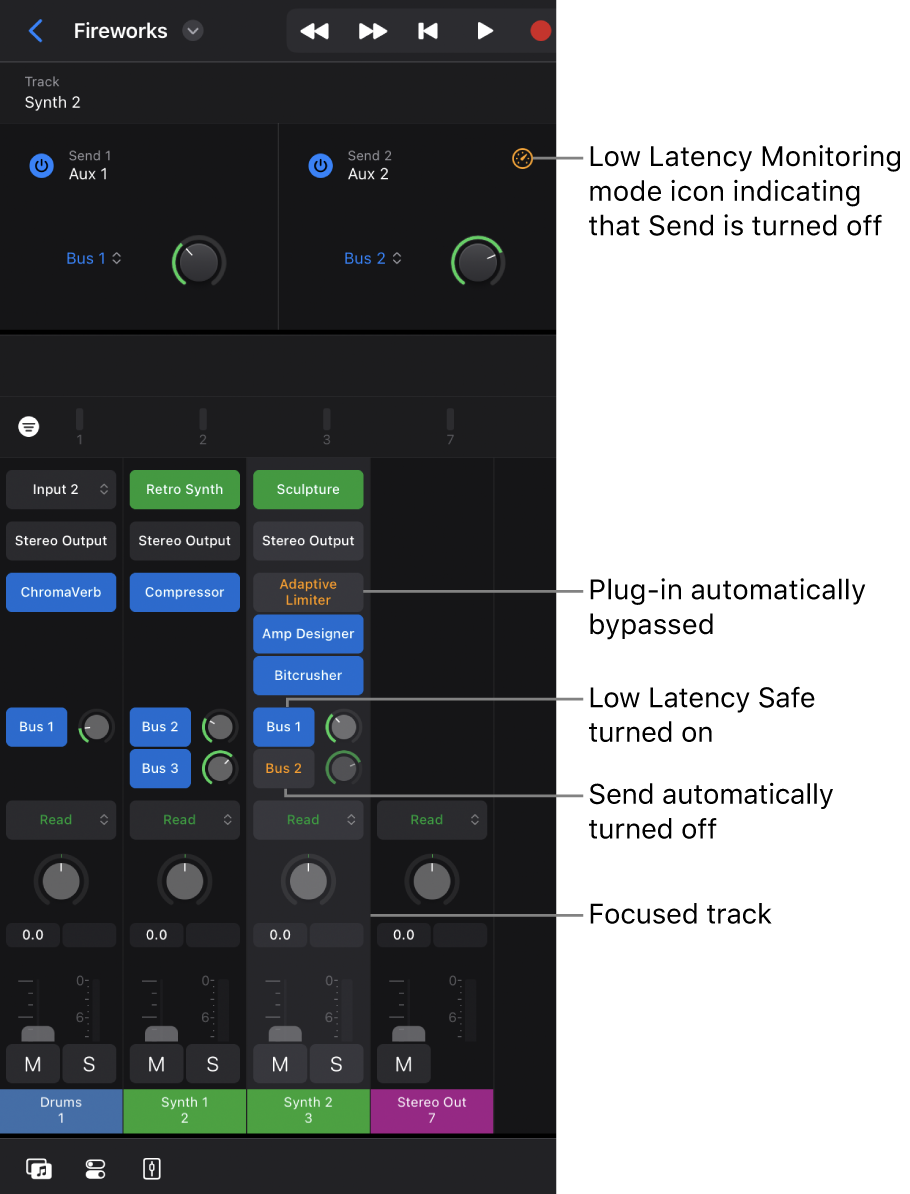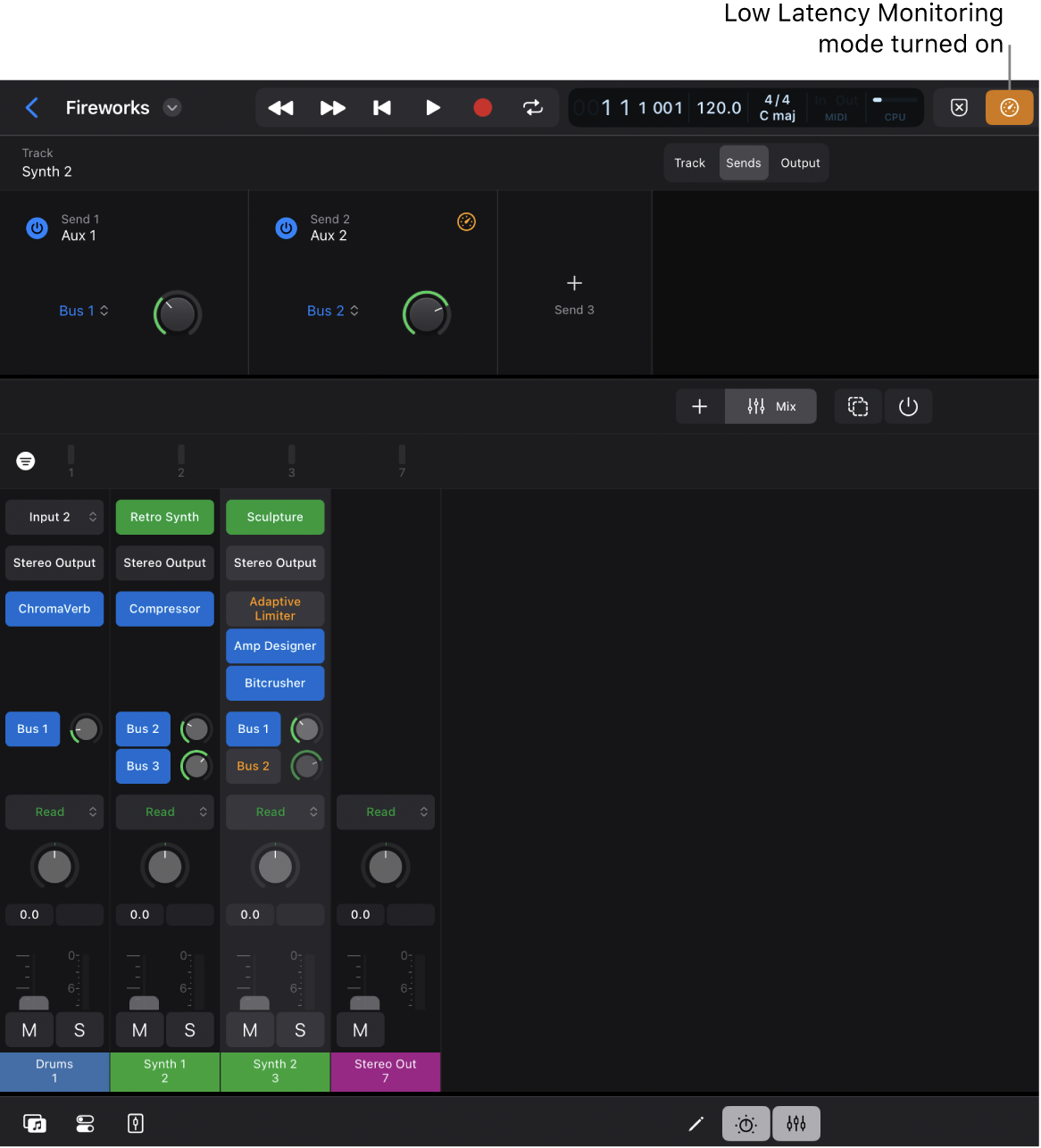Logic Pro User Guide for iPad
-
- What is Logic Pro?
- Working areas
- Work with function buttons
- Work with numeric values
- Undo and redo edits in Logic Pro for iPad
-
- Intro to tracks
- Create tracks
- Create tracks using drag and drop
- Choose the default region type for a software instrument track
- Select tracks
- Duplicate tracks
- Reorder tracks
- Rename tracks
- Change track icons
- Change track colors
- Use the tuner on an audio track
- Show the output track in the Tracks area
- Delete tracks
- Edit track parameters
- Start a Logic Pro subscription
- How to get help
-
- Intro to recording
-
- Before recording software instruments
- Record software instruments
- Record additional software instrument takes
- Record to multiple software instrument tracks
- Record multiple MIDI devices to multiple tracks
- Record software instruments and audio simultaneously
- Merge software instrument recordings
- Spot erase software instrument recordings
- Replace software instrument recordings
- Capture your most recent MIDI performance
- Route MIDI internally to software instrument tracks
- Record with Low Latency Monitoring mode
- Use the metronome
- Use the count-in
-
- Intro to arranging
-
- Intro to regions
- Select regions
- Cut, copy, and paste regions
- Move regions
- Remove gaps between regions
- Delay region playback
- Trim regions
- Loop regions
- Repeat regions
- Mute regions
- Split and join regions
- Stretch regions
- Separate a MIDI region by note pitch
- Bounce regions in place
- Change the gain of audio regions
- Create regions in the Tracks area
- Convert a MIDI region to a Session Player region or a pattern region
- Replace a MIDI region with a Session Player region in Logic Pro for iPad
- Rename regions
- Change the color of regions
- Delete regions
-
- Intro to chords
- Add and delete chords
- Select chords
- Cut, copy, and paste chords
- Move and resize chords
- Loop chords on the Chord track
- Color chords on the Chord track
- Edit chords
- Work with chord groups
- Use chord progressions
- Change the chord rhythm
- Choose which chords a Session Player region follows
- Analyze the key signature of a range of chords
- Create fades on audio regions
- Extract vocal and instrumental stems with Stem Splitter
- Access mixing functions using the Fader
-
- Intro to Step Sequencer
- Use Step Sequencer with Drum Machine Designer
- Record Step Sequencer patterns live
- Step record Step Sequencer patterns
- Load and save patterns
- Modify pattern playback
- Edit steps
- Edit rows
- Edit Step Sequencer pattern, row, and step settings in the inspector
- Customize Step Sequencer
-
- Intro to mixing
-
- Channel strip types
- Channel strip controls
- Peak level display and clipping
- Set channel strip volume
- Set channel strip input format
- Set the output for a channel strip
- Set channel strip pan position
- Mute and solo channel strips
- Reorder channel strips in the Mixer in Logic Pro for iPad
- Replace a patch on a channel strip using drag and drop
- Work with plug-ins in the Mixer
- Search for plug-ins in the Mixer in Logic Pro for iPad
-
- Effect plug-ins overview
-
- Instrument plug-ins overview
-
- ES2 overview
- Interface overview
-
- Modulation overview
- Use the Mod Pad
-
- Vector Envelope overview
- Use Vector Envelope points
- Use Vector Envelope solo and sustain points
- Set Vector Envelope segment times
- Vector Envelope XY pad controls
- Vector Envelope Actions menu
- Vector Envelope loop controls
- Vector Envelope point transition shapes
- Vector Envelope release phase behavior
- Use Vector Envelope time scaling
- Modulation source reference
- Via modulation source reference
-
- Sample Alchemy overview
- Interface overview
- Add source material
- Save a preset
- Edit mode
- Play modes
- Source overview
- Synthesis modes
- Granular controls
- Additive effects
- Additive effect controls
- Spectral effect
- Spectral effect controls
- Filter module
- Low, bandpass, and highpass filters
- Comb PM filter
- Downsampler filter
- FM filter
- Envelope generators
- Mod Matrix
- Modulation routing
- Motion mode
- Trim mode
- More menu
- Sampler
- Studio Piano
- Copyright
Record with Low Latency Monitoring mode in Logic Pro for iPad
All plug-ins cause timing delays, known as latency, when processing audio. Small delays are not audible; however, the more processor-intensive a plug-in is, the bigger its latency will be. In addition, many channel strips in your project might have different plug-ins, meaning different tracks are played back with a different delay, causing sync issues. Logic Pro automatically applies plug-in delay compensation (PDC) by detecting the channel strip with the maximum latency due to its latency-causing plug-ins, and based on that, delaying the other channel strips in real time by an individual amount so that all tracks play back in sync.
Although this slight playback delay is not a problem when you play back your project during mixing, it makes it difficult to perform with proper timing when you record on a track. To avoid that delay, you can turn on Low Latency Monitoring mode that turns off plug-in delay compensation on the focused instrument track and any record-enabled tracks. This affects the plug-ins and the Aux sends on those tracks:
Bypassed plug-ins: Any plug-in that pushes the track’s total latency value above the set limit is bypassed. Those plug-ins show a gray plug-in button with orange text in the Mixer and an orange plug-in name and Low Latency Monitoring mode icon
 in the Details view of the Plug-ins area.
in the Details view of the Plug-ins area.Focused instrument tracks show the bypassed slots once you start the playback.
Deactivated Aux sends: Every Send slot is turned off. This is indicated by a gray Send button with orange text and an orange Low Latency Monitoring mode icon
 in the Sends view of the Plug-ins area.
in the Sends view of the Plug-ins area.Tip: A Low Latency Safe option in the Sends pop-up menu lets you turn on a Send slot again, which is useful when you routed the track’s signal to a reverb that you want to hear during recording.

Note: In addition to the plug-in latencies, there are other components that introduce latencies. For example, MIDI controllers connected via Bluetooth, the input and output stage of your selected audio interface, or the I/O Buffer Size value. For details, see Audio Devices settings.
Turn Low Latency Monitoring mode on or off
In Logic Pro, do one of the following:
Tap the Low Latency Monitoring Mode button
 in the control bar.
in the control bar.The Low Latency Monitoring Mode button does not appear in the control bar by default. To add this button to the control bar, see Customize the control bar.
Tap the More button
 in the control bar, tap Settings > App Settings > Audio > General, then tap the Low Latency Monitoring Mode switch.
in the control bar, tap Settings > App Settings > Audio > General, then tap the Low Latency Monitoring Mode switch.
When you turn on Low Latency Monitoring mode, the Limit field below the Low Latency Monitoring Mode switch appears in the General Audio settings. It lets you determine the maximum amount of allowed latency across the entirety of the record-enabled track’s signal path (up to 30 ms).
WARNING: The sound may change when you turn on Low Latency Monitoring mode. Depending on the plug-ins in use, the change in sound can be anything from subtle to dramatic. If plug-ins being used do not exceed the total latency limit, there is no audible difference.
Reactivate an Aux send in Low Latency Monitoring mode
With Low Latency Monitoring mode turned on, all Send slots on a record-enabled channel strip are turned off. This is indicated by their gray buttons with orange text in the channel strip and by an orange Low Latency Monitoring mode icon in the Sends view of the Plug-ins area.
In Logic Pro, select the record-enabled track and do one of the following:
Tap the Mixer button
 in the view control bar to show the channel strip you want to record on.
in the view control bar to show the channel strip you want to record on.Tap the Plug-ins button
 in the view control bar, then tap the Sends button.
in the view control bar, then tap the Sends button.
Tap the Sends pop-up menu and choose Low Latency Safe.
The Send button changes to blue, and the orange Low Latency Monitoring mode icon
 disappears.
disappears.
To deactivate the Send again, tap the Low Latency Safe option in the Sends pop-up menu to deselect it.
Download this guide: PDF